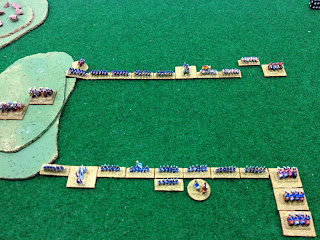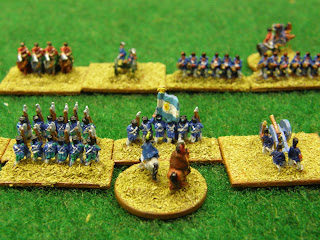 |
| Upper Peru |
But the great thing about wargaming is that if I want a campaign for Upper Peru in 1817, I can have one. I just make it up.
Those who follow this blog will know that I sometimes use a variant of HOTT to fight battles of the South American Wars of Liberation. It's under constant refinement, but generally gives good games which capture the flavour of the period whilst keeping HOTT's relative simplicity. But I fancied trying something more - a campaign. So a week or so ago I threw together a few ideas for running a series of linked battles, using the 1811-1815 Upper Peru campaigns as a model. What I wanted was a method of fighting 'conventional' HOTT-style games, but with the compositions of each army determined by the results of previous games.
I won't be posting the rules here just yet, as they're still under development, but tonight at the UoW Gamer's Guild Caesar and I gave the system a try. And it worked pretty well. We managed a couple of games, and got out of them just what is required from a campaign - a sense of a story being told and of continuity.
The most recent version of Liberated HOTT can be found on my Free Stuff page. We used Version 2.0 for these games.
The campaign itself is mapless. Whilst geography played a role in these particular South American campaigns, control of territory wasn't about occupying land, but really a matter of defeating the opposing army, wherever it was, then wining local hearts and minds. In my campaign both players start with three political tokens. If you win a battle, you take a political token from your opponent. You win the campaign when your opponent has no political tokens left. So, win three consecutive battles, and you win the war.
Both players start with a twelve element army, consisting of eight Infantry, three Cavalry and an Artillery element, plus a General. All elements start as militia, but a series of dice rolls can cause units to be upgraded to regular or (rarely) elite. The General can have certain characteristics as well - a good General is allowed to reroll his PIP die once per game, whereas a poor General's opponent can force a PIP reroll on him once per game.
Battles are fought in the normal way. After each battle, surviving elements can be promoted in quality, and lost elements brought back. Both armies are brought back up to strength with militia replacements, with the smaller army always being twelve elements in size, and the other a few elements larger. In that way if you destroy the enemy army in one battle, you will have a numerical advantage in the next.
So how did it play out?
Caesar took the Royalists, and got a good army; a couple of regular Infantry elements and one elite, as well as an element of regular Cavalry. His general had average tactical ability, but was a craven coward, which meant that he might abandon his army if he thought defeat was a possibility.
I had the Patriots. I was less lucky with my upgrade rolls, and had an army made up mostly of militia, with one each of a regular Infantry and Cavalry element. My general, though, was good, which allowed him a single PIP reroll each game.
On to the first game - the Battle of Juyjuy (I used an 1831 map of the area to produce a list of names for battle site, and then we rolled to see where we were).
The Patriots defended, and ended up with a small town to their rear, and a line of hills running along the left of the battlefield:
The armies advanced - Patriots at the bottom of the picture, Royalists at the top:
Both armies used their cavalry to attack the enemy left, with mixed results. The Royalists inflicted some casualties, but both armies pretty much lost their cavalry:
Royalist militia cavalry rout a Patriot infantry unit:
The two infantry lines engaged:
And engaged closer still. The Royalist general considered abandoning his army but his resolve held:
Casualties mounted on both sides, but the Patriots broke first - the battle was a Royalist victory:
Into the post-game phase the Royalists managed to upgrade some of their elements, whilst the Patriots didn't. Both generals survived being replaced for political reasons (losing a battle or winning too many battles could make this more likely). Both armies were made up to strength with militia replacements, the type of elements being randomly determined.
When the armies met again their makeup was as follows:
Royalists - General (Coward), 5 militia Infantry, 2 regular Infantry, 2 elite Infantry, 2 militia Cavalry, 1 regular Cavalry, 1 militia Artillery, 2 Mobs - 14 elements total.
Patriots - General (Good), 10 militia Infantry, 1 regular Infantry, 1 militia Artillery - 12 elements total
The next battle was fought outside the town of Salta. The Royalists defended, and ended up with a relatively open field; just the town itself and a rocky hill on the Patriot side of the battlefield. The Patriots anchored their line on the hill and town, and waited for the larger, more experienced, Royalist army to attack. The Royalists obliged:
The Patriot general leads his troops into battle:
This was a fierce fight. The Royalists attacked the town with their elite and regular infantry, whilst their cavalry ended up under Patriot musketry on the other flank and suffered for it. It was the generals who provided the drama, though. Firstly the Patriot general used his PIP reroll to produce a master-stroke, exploiting a gap in the Royalist line and leading his infantry in a fierce charge on the enemy:
This caused the Royalist general to panic - he deserted his army. In Liberated HOTT loss of a general doesn't automatically cause an army's defeat, but it does contribute to it - the Royalists were now in trouble, with nearly half of their army gone. The Patriots pressed their attack, but their own casualties were mounting:
The Royalist army won a bloody, pyrrhic victory in spite of, rather than because of, their general.
Neither army managed to salvage much from their casualties, and once again both armies kept their generals; the Royalist general obviously had friends in high places or knew how to write a very carefully-worded report. Both armies saw little in the way of upgrades. A few weeks after the Battle of Salta the forces were as follows:
Royalists - General (Coward), 6 militia Infantry, 2 regular Infantry, 2 elite Infantry, 3 militia Cavalry, 1 regular Cavalry, 2 Mobs - 15 elements total
Patriots - General (Good), 8 regular Infantry, 1 regular Infantry, 3 militia Cavalry - 12 elements total
At that stage we called it a night. If the Patriots lose the next battle they lose the campaign, and the Royalists certainly have most of the advantages. But, as the second game showed, you can't be totally sure of victory.
Both games were good fun, and we actually thought of a couple of refinements to the rules which I'll try out at some stage before adding to the latest version. The campaign rules held up well and, again, we came up with some additions and changes which I'll organise and write up. We may not finish this particular campaign if the changes look suitably interesting; it's easy enough to start again
Meanwhile on the other table Dave and Geoff played big-battle DBA - Moslem Indians against Byzantines. It sounds like things may have gone horribly wrong for Geoff's Byzantines:














The Liberated Hordes rules are the simplest Horse & Musket rules I know but still make for a realistic battle. Subtle refinements will make them among my favourite. Impetuous assault columns and slightly better artillery would be great. Although guns weren't a key player in the South American conflicts they still seem a touch weak to justify their existence. For larger battles, sub commanders might be the way to go. The linear campaign makes several small HOTT battles into something really absorbing - must do this again.
ReplyDeleteIf you get +1 for firing in troops in 'column' as we discussed, then you may find Artillery has an interesting effect - it gives it good odds of knocking off infantry units at closer range, and can certainly help break up an attack.
DeleteWe're playing the 12 element variant of Liberated HOTT - the basic rules assume sub-commanders, but a lot of battles didn't really have them; the CinC was in effective control of the whole battle.
I really like this idea. A nice simple campaign with period flavour that I can play in a couple of nights. Looking forward to seeing the rules.
ReplyDelete